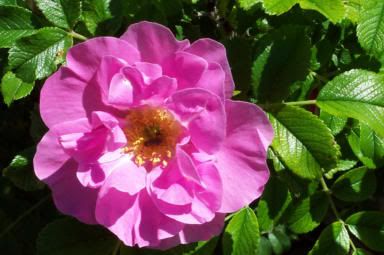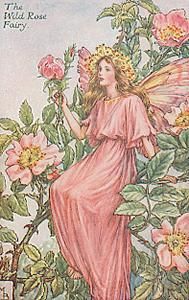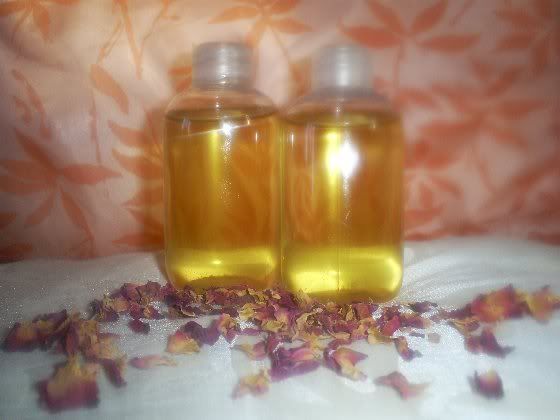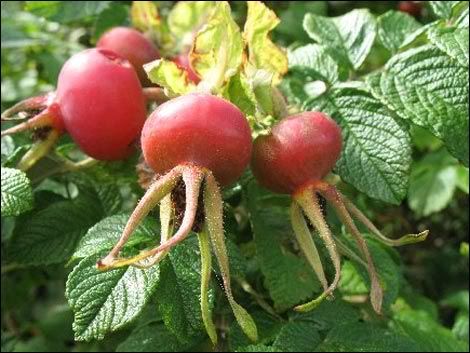
Description:
It is almost entirely superfluous to provide a description of a plant that is so well known around the world. But for the sake of completion, I will offer these general notes:
There are about 150 species of wild roses, mostly shrubs and climbers, which occur wild in the northern hemisphere. Most wild rose species are distinguished by their 5-petaled white or pinkish flowers and the profusion of yellow stamen in their center. (Cultivated varieties can take on many different forms and colour variations - they may display large or small, packed or single flowers, scented or unscented, etc etc.) Wild Rose shrubs can be as low as 80cm or climb some 30m high by sprawling over other plants and trees. They are prickly fellows and although the thorns of natural varieties tend to be much finer than those of the hybrids, they are no less sharp or tenacious. Leaves tend to be pinnate, with stalked, ovate leaflets and finely toothed margins. The stems and leaves bear thorns In autumn they produce bright red, pear-shaped seed-pods with a hard, thin, outer skin. Their center is filled with small triangular seeds embedded in scratchy fluff (which children utilize as itching powder). These fruits are known as rosehips and famous as a rich source of vitamin C.

Ecology:
They may occur in open woodland, fields and heaths, or even on dunes and sandy ground. Their thorny nature offers effective protection for small animals, effectively warding off predators and human intrusion. They are often planted among the hedgerows, although the fruits don't seem to be the most favourite of wild fruit species, as they can often be seen adorning the bare bushes and glowing bright red long after other fruits have been decimated by the little creatures. However, their rich vitamin C content makes them popular with humans.
Distribution:
Roses occur naturally in temperate regions of the northern hemisphere, from China to North America. Their greatest center of diversity is in central Asia.
sleeping (94K)
History & Mythology
It is a little difficult to disentangle the various strands of rose history. Most of the literature centers on the old cultivated varieties, in particular R. gallica, a deep red, fragrant flower, also known as Provins Rose (after a small town near Paris, a former center of Rose cultivation and trade, not the region known as Provence). The beautiful Rose has inspired horticultural passions since ancient times (at least 5000 years), which makes it very difficult to trace exactly which roses have mingled to produce new varieties. Roses were among the first plants (if not THE first plant) that were grown for beauty's sake alone, a practice that flourished in Asia and the Middle East long before it had ever been heard of in Europe. Roses adorned the patios and pleasure gardens of palaces, serving as a supreme image of female virtues.

The Rose has become synonymous with love, an attribute that it held since ancient times. The Greeks already regarded Roses as sacred to Venus, and some say that it sprang from the tears of the Goddess as they mingled with the blood of her lover Adonis, while he lay dying. Although some sources give this claim to fame to the scarlet Pheasant's Eye, (Adonis annua), judging by the Rose' ancient associations with various funeral cults, the Rose is the more likely candidate. Rose symbolism has long been used to signify the approach of death and a 'rose garden' is often regarded as synonymous with 'grave yard'. This symbolism is still reflected in various old fairy tales, e.g. Sleeping Beauty, who falls into a magical sleep after pricking herself with the spindle. The entire castle and all within it becomes engulfed in an impenetrable mass of rambling Roses until she is finally reborn by the love of her prince. Ancient myths often mingle the symbols of life, death and love - after all they are all closely connected. The red colour of the Rose symbolizes blood and blood is regarded as the magical carrier of the life-force itself. Modern dualistic perceptions on the other hand tend to regards life and death as mutually exclusive opposites instead of different phases of the circle of life.
As the case may be, it is universally agreed that the rose is sacred to the Goddess of Love. Since earliest times Arabic perfumers knew the secrets of this beautiful flower and incorporated its scent into perfumes and cosmetics. The Damask Rose, the result of crossbreeding Rosa gallica with either Rosa phoenicia or Rosa moschata, still serves as the source of Rose Otto.
Note: In case you ever wondered why anything to do with roses should be named Otto - the term is anadulturation of 'Attar' which itself is the western phonetic version of the arabic term 'itr' - which means 'essence'. Thus 'Rose Otto' means Rose essence, but these days the term is used to describe steam distilled rose oil.
rosescent (57K)Although it is said that Avicenna was the first to discover distillation in the 10th century, remains of essential oils have even been found in the ancient tombs of the Egyptians, and ancient alembic stills that date back thousands of years before Christ. One of the most ancient methods of extraction was to simply macerate fragrant flowers in oil, a primitive form of enfleurage. Another story claims that rose oil was discovered accidentally - in a most romantic fashion of course: In preparation for a royal wedding, the waterways that meandered through the palace gardens had been filled with rose petals. Engulfed by the heavenly scent, the couple floated through this bed of roses in their barge, when they suddenly noticed a layer of oil on the water - the heat of the midday sun had helped to extract the oils naturally and thus the essential oil of roses was discovered.

The Ladies of those ancient days valued the heady, warm, sweetly-spiced scent of Roses no less than modern women do. Then as now, this sensual aroma is universally believed to inspire love, a power that even Cleopatra had to qualms to employ in her endeavour to seduce Mark Antony. Filling her bedroom with a 2 feet carpet of rose petals, Mark Antony evidently never stood a chance.
In their most decadent era, the Romans were infamous for their lavish (some would say 'wasteful') use of rose petals - they showered returning warriors with the petals as if they were confetti, they poured them over banquets to the point of nearly suffocating their guest, and covered floors and beds with the fragrant petals - perhaps the origin of 'strewing herbs'. They also worked them into a myriad of medicinal concoctions and foods, not to mention their cosmetic applications. To satisfy their ravenous appetite for the precious flowers, they even went as far as ripping out fruit orchards to make way for rose cultivation.
rose3 (43K)One of the oldest Rose cultivars is R. gallica - the apothecary's rose. This variety is highly fragrant, but only has one flowering season. Most probably the Romans first introduced this Rose to northern Europe, but it may have been lost and forgotten again until the crusaders also brought them home from the holy land during the 10th century. Monks took them into their monastery gardens and tended them with devotion, trying hard to give this most sensuous flower, emblem of female sexuality and love, a chaste Christian image by linking it to the virginal love of the Virgin Mary. But try as they might - the Rose never lost its pleasure orientated associations of romantic, carnal love - as sales figures on Valentine's Day demonstrate clearly.
tudor (26K)By the 15th century the rose had become a royal emblem in Britain and when a decisive power struggle ensued between two royal houses, it became known as 'the war of the roses'. The house of Lancaster had adopted the red rose (Rosa gallica?) as their emblem, while the house of York had adopted the white rose (Rosa alba?). After many battles peace was eventually brought to the two families by the marriage of Henry the VII (house of Lancaster) and Elizabeth (house of York), and the two roses were united to bring forth the Tudor Rose, which became their heraldic emblem as the Rose of Britain. However, this Rose remains an idealistic fantasy - although scores of horticulturalists have attempted to actually create a rose that would bear both red and white petals within the same flower, none have so far succeeded. And while there is a hybrid that bears the name of both royal houses, it does not really resemble the stylized Tudor Rose, which has become the Rose of England.
At one stage there was such a fascination with all things rosy and beautiful, it was only natural that apothecaries of the day developed a Rose cult of their own. They invented an entire pharmacopoeia based on the Rose and its infinite uses. John Gerard, the famous British Herbalist writing in the 15th century devoted some 13 pages to the virtues of the Roses. Rose petal tea, syrup, jelly and preserves, powders, pomades, pastilles and electuaries, liqueurs, tonic wine and honey were part of this repertoire - not to mention rosewater and oil. Some of these have survived to this day, although in general Roses are no longer used medicinally. If used at all their purpose is as a flavouring agent, to sweeten medicine, or as a therapeutic ingredient in cosmetics.
Folkmedicine employed Roses 'sympathetically' to stay the flow of blood and to sooth inflammation and burns.
Medicinal uses
Parts used:

Petals, essential oil, fruit
Harvest:
Petals: Early morning, before the sun reaches the zenith.
Rosehips: After the first frost.
Constituents and Actions:
Petals:
The petals are the source of the essential oil, which gives them their characteristic scent. However, the amount of essential oil present is very small indeed. It requires 5000kg of rose petals to yield 1kg of the essential oil, if obtained by distillation. Concentration of essential oils is highest early in the morning , before the sun reaches its zenith. Flower pickers have to work from dawn to midmorning to pick the flower heads. Solvent extraction, which yields the 'Absolute' is more effective, producing 10 times as much essential oil and also preserving some of the more fragile compounds. However - in Aromatherapy Absolutes are usually avoided because of possible hexane residues.

Rose Oil
The essential oil of Rose consists of a highly complex combination of more than 300 different compounds, which chemists still can't imitate in the laboratory. Aamong them are: citronellol, geraniol, nerol, linalool, phenyl ethyl alcohol, farnesol, stearoptene, ?-pinene, ß-pinene, ?-terpinene, limonene, p-cymene, camphene, ß-caryophyllene, neral, citronellyl acetate, geranyl acetate, neryl acetate, eugenol, methyl eugenol, rose oxide, ?-damascenone, ß-damascenone, benzaldehyde, benzyl alcohol, rhodinyl acetate, phenyl ethyl formate . But only a few are responsible for the distinctive scent. These are beta-damascenone, beta-damascone, beta-ionone, and rose oxide.
The different species used for oil production yield different compositions of oils and thus different scents. Moroccan Rose Oil (Rosa centifolia) is rich in Phenylethanol (63%), but contains less Citronellol (10-15%), Geraniol and Nerol (8%). The Bulgarian type (Rosa damascena) is naturally rich in Citronellol (35-55%), Geraniol and Nerol (40%) but only 2% Phenylethanol. Although traditionally Rosa gallica supplied the demand for Rose petals used for medicinal purposes, it is no longer possible to ascertain the exact species of red roses in circulation in the trade today. Rose petals used medicinally should be of a healthy, deep crimson colour and have a strongly aromatic scent.
Rosehips:

The fruits of wild roses are very rich in vitamins and minerals. Their vitamin C content surpasses that of oranges or kiwis. For many years they were 'official' in the pharmacopeias, but are now reduced to the status of flavouring agent, especially for fruity tea blends. Recent tests have shown the seeds to contain essential fatty acids. Thus, the seeds are now processed to obtain a) a CO2 extracted essential oil and b) a cold pressed oil. The cold pressed oil contains gamma Linolenic acid (GLA), which has a host of therapeutic uses for the skin, and also as a hormonal precursor. The oils is not usually used internally though, but is highly recommended for cosmetic products to tone dry, tired skin. The seeds are embedded in fine hairs, which can cause irritation.

Medicinal uses
The following information is largely historical as few herbalists still use neither rosehips nor rose petals therapeutically.
Ancient herbalists made very acute observations of the plant materials they used. Tabernaemontanus describes in great detail the different qualities of various types of roses. He notes that Apothecary's Rose is astringent and slightly bitter, not as noble as some of the other types. Fresh rose petals are more bitter than dried ones, which tend to be more astringent. He recommends them mostly for mild diarrhea.
Culpeper recommends their astringent virtues:
The Decoction of Red Roses made with Wine and used, is very good for the Headach, and pains in the Eyes, Ears, Throat, and Gums, as also for the Fundament, the lower Bowels, and the Matrix, being bathed, or put into them. The same Decoction with the Roses remaining in it is profitably applyed to the Region of the Heart to eas the Inflamation therin; as also St. Anthonies fire, and other Diseases of the Stomach. Being dried and beaten to Pouder, and taken in steeled Wine or Water, it helpeth to stay Womens Courses. The yellow threds in the middle of the red Roses (wch are erroniously called the Rose Seeds) being poudered and drunk in the distilled water of Quinces, stayeth the overflowing of Womens Courses, and doth wonderfully stay the Defluxions of Rhewm upon the Gums and Teeth, preserving them from corruption, and fastning them if they be loose, being washed and gargled therewith, and some Vinegar of Squils added thereto.
Rose petals astringency has been employed to stop bleeding and to inhibit unnatural fluxes. Teas or decoctions have been used to treat colds, bronchial infections, gastritis, diarrhoea, and as a tonic to lift depression and lethargy.
Externally, they have been used to treat eye infections (eye wash), sore throats, laryngitis and stomatitis (gargle) as well as minor injuries and skin problems. The old herbalists used them to treat 'the rose' (an inflammatory condition - shingles?) and other types of inflammation since they considered rose to be a cooling herb.

Rosewater was also much used, especially to treat sore and inflamed eyes and also for skin conditions.
Today, mostly Rose essential oil is used therapeutically, especially to treat female conditions, such as menstrual and menopausal problems, where these are related to emotional problems. Aromatherapy values it as an excellent oil to treat physical problems that have their root in the emotional sphere. Rose oil opens and balances the heart chakra and gently unclogs any energy congestion that may be at the root of such 'female troubles'. Rose can promote self-acceptance. It seems to subtly adjust the balance between give and take and can help with issues related to repressed sexuality. Rose oil is said to ally emotional pain that arises from insecurity and lack of self-love, such as jealousy, possessiveness, disappointments and sadness caused by inappropriate or excessive attachment, fear of letting go, heartaches and depression.
Rosehips:
rosehip (46K)Rosehips are often given as a standard children's tea, with good reason: rosehip tea is refreshing and full of vitamins. In particular, they are rich in vitamin C, A and K. The red pigment is due to lycopene, the same substance that gives tomatoes their colour and healthful properties. Lycopene has been investigated as a cancer inhibiting substance. Rosehips offer great support for the immune system and can help to fight free radicals. Various rosehip concoctions, such as rosehip syrup, rosehip soup, or wine have long been popular, especially in northern countries. However, great care must be taken when preparing the hips, as the vitamin C content deteriorates very quickly upon cutting. This is due to an enzyme, which initiates the breakdown upon exposure to oxygen. To prevent this, the hips are cut and immediately submerged in hot water, which kills the enzyme. The hips must be cleansed from the seeds and, most importantly, from the fine hair, which can cause irritation if ingested. Cleaning each hip out separately is an extremely slow and tedious process. One method is to pour the hot liquid into a food processor to puree everything and then to filter it by pressing it through a linen cloth, which filters out the hair and seeds. Centrifugal extraction (juicer) also offers good results. For more on rosehip processing see Foraging Rosehips
Rosehip Seed Oil
Dermatological research in Chile has found Rosehip seed oil to be extremely nutritious and healing for the skin. The oil is very rich in polyunsaturated fatty acids, especially GLA. This oil is obtained from a variety of roses native to the Chilean Andes. Due to their high essential fatty acid content (80%), the seeds yield a light, gently astringent oil with excellent nourishing, moisturizing and toning qualities. Rosehip oil is not used for culinary purposes, but makes a very rich nutritive oil for cosmetic purposes, particularly for facial blends and lotions intended to nourish tender tissues around the eyes and to maintain skin tone. Excellent for use in 'after sun care' lotions, and on burnt tissue, stretch marks, seborrheic dermatitis, inflamed or aging skin, as well as on scars, wounds and burns.
recipes (1K)

There are numerous ways to use rosehips or rose flowers, to make delicious syrups, conserves, jams etc. In my experience the best way to process the hips is to grind them in a coffee grinder or food processor and then to use the whole mash in the recipe. Strain the liquid later, to filter out seeds and hairs.
Rosehip Soup
This is a Scandinavian recipe, where berry soups are not thought of as weird.
* 100g rosehips
* 100g honey (or sugar)
* 50g starch
* 1 lemon
* 1l water
Mash the Rosehips in a grinder or food processor and immediately add to the boiling water. Add the juice and zest (if you are using untreated) lemon. Dissolve the starch with a little water and stir into the liquid. Bring to the boil while stirring continuously until it thickens slightly. Other spices may be added, such as vanilla, cinnamon or clove.
Rose Petal Syrup
This syrup can produce quite different flavours depending on what sort of rose you use. I prefer the less perfumed ones, like ordinary Dog Rose. Others like the strong flavour of R.gallica.
* 30g Rose petals (R.canina)
* 700g sugar
* 1l water
Dissolve the sugar in the water and bring to the boil. Pour over the Rose petals and return to the heat until it has reached boiling point again. Cover and macerate for 12h. Strain and fill into sterilized jars.
Face Mask (oily skin)
This face mask cleanses the skin deeply, drawing impurities, tightening the pores and drying oily skin. Should not be applied more than once or twice a week.
* 1 Tablespoon of Green Clay or Fullers Earth
* 2-3 Tablespoons of Rosewater
* ½ teaspoon runny honey
* 1 drop of Rose Otto
* 1 drop of Geranium oil
Moisten the clay with the rosewater and honey to make a paste. Add the essential oils. Apply to the face and neck and leave for about 10 minutes. Wash off with plenty of warm water. Dapple skin with rosewater and apply a gentle, soothing oil, such as almond or peach kernel oil.

Wonderful as always Dear Sister! :)
ReplyDeleteBlessings to you this day and always!
All my Love!
Thank you beautiful one.I can always count on you to make my day brighter.Love you immensely.
ReplyDelete